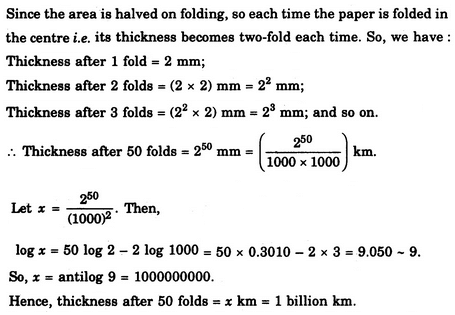LR Exam > LR Questions > If a 1 mm thick paper is folded so that the a...
Start Learning for Free
If a 1 mm thick paper is folded so that the area is halved at every fold, then what would be the thickness of the pile after 50 folds ?
- a)100 km
- b)1000 km
- c)1 million km
- d)1 billion km
Correct answer is option 'D'. Can you explain this answer?
Verified Answer
If a 1 mm thick paper is folded so that the area is halved at every fo...

Most Upvoted Answer
If a 1 mm thick paper is folded so that the area is halved at every fo...
Introduction:
In this problem, we are given a 1 mm thick paper that is folded in such a way that the area is halved at every fold. We need to determine the thickness of the pile after 50 folds.
Approach:
To solve this problem, we can use the concept of exponential growth. Each time the paper is folded, its thickness doubles. Therefore, after the first fold, the thickness becomes 2 mm, after the second fold it becomes 4 mm, and so on.
Calculation:
Let's calculate the thickness of the paper after each fold:
- After 1 fold: Thickness = 1 mm * 2 = 2 mm
- After 2 folds: Thickness = 2 mm * 2 = 4 mm
- After 3 folds: Thickness = 4 mm * 2 = 8 mm
- After 4 folds: Thickness = 8 mm * 2 = 16 mm
We can observe that after each fold, the thickness of the paper doubles. Therefore, after 50 folds, the thickness would be:
- After 50 folds: Thickness = 1 mm * 2^50
Now, let's calculate the value of 2^50:
2^50 = 1,125,899,906,842,624
Therefore, the thickness of the pile after 50 folds would be:
Thickness = 1 mm * 1,125,899,906,842,624 = 1,125,899,906,842,624 mm
Final Answer:
The thickness of the pile after 50 folds would be 1,125,899,906,842,624 mm, which is approximately equal to 1 billion km. Therefore, the correct answer is option D) 1 billion km.
In this problem, we are given a 1 mm thick paper that is folded in such a way that the area is halved at every fold. We need to determine the thickness of the pile after 50 folds.
Approach:
To solve this problem, we can use the concept of exponential growth. Each time the paper is folded, its thickness doubles. Therefore, after the first fold, the thickness becomes 2 mm, after the second fold it becomes 4 mm, and so on.
Calculation:
Let's calculate the thickness of the paper after each fold:
- After 1 fold: Thickness = 1 mm * 2 = 2 mm
- After 2 folds: Thickness = 2 mm * 2 = 4 mm
- After 3 folds: Thickness = 4 mm * 2 = 8 mm
- After 4 folds: Thickness = 8 mm * 2 = 16 mm
We can observe that after each fold, the thickness of the paper doubles. Therefore, after 50 folds, the thickness would be:
- After 50 folds: Thickness = 1 mm * 2^50
Now, let's calculate the value of 2^50:
2^50 = 1,125,899,906,842,624
Therefore, the thickness of the pile after 50 folds would be:
Thickness = 1 mm * 1,125,899,906,842,624 = 1,125,899,906,842,624 mm
Final Answer:
The thickness of the pile after 50 folds would be 1,125,899,906,842,624 mm, which is approximately equal to 1 billion km. Therefore, the correct answer is option D) 1 billion km.

|
Explore Courses for LR exam
|

|
Question Description
If a 1 mm thick paper is folded so that the area is halved at every fold, then what would be the thickness of the pile after 50 folds ?a)100 kmb)1000 kmc)1 million kmd)1 billion kmCorrect answer is option 'D'. Can you explain this answer? for LR 2025 is part of LR preparation. The Question and answers have been prepared according to the LR exam syllabus. Information about If a 1 mm thick paper is folded so that the area is halved at every fold, then what would be the thickness of the pile after 50 folds ?a)100 kmb)1000 kmc)1 million kmd)1 billion kmCorrect answer is option 'D'. Can you explain this answer? covers all topics & solutions for LR 2025 Exam. Find important definitions, questions, meanings, examples, exercises and tests below for If a 1 mm thick paper is folded so that the area is halved at every fold, then what would be the thickness of the pile after 50 folds ?a)100 kmb)1000 kmc)1 million kmd)1 billion kmCorrect answer is option 'D'. Can you explain this answer?.
If a 1 mm thick paper is folded so that the area is halved at every fold, then what would be the thickness of the pile after 50 folds ?a)100 kmb)1000 kmc)1 million kmd)1 billion kmCorrect answer is option 'D'. Can you explain this answer? for LR 2025 is part of LR preparation. The Question and answers have been prepared according to the LR exam syllabus. Information about If a 1 mm thick paper is folded so that the area is halved at every fold, then what would be the thickness of the pile after 50 folds ?a)100 kmb)1000 kmc)1 million kmd)1 billion kmCorrect answer is option 'D'. Can you explain this answer? covers all topics & solutions for LR 2025 Exam. Find important definitions, questions, meanings, examples, exercises and tests below for If a 1 mm thick paper is folded so that the area is halved at every fold, then what would be the thickness of the pile after 50 folds ?a)100 kmb)1000 kmc)1 million kmd)1 billion kmCorrect answer is option 'D'. Can you explain this answer?.
Solutions for If a 1 mm thick paper is folded so that the area is halved at every fold, then what would be the thickness of the pile after 50 folds ?a)100 kmb)1000 kmc)1 million kmd)1 billion kmCorrect answer is option 'D'. Can you explain this answer? in English & in Hindi are available as part of our courses for LR.
Download more important topics, notes, lectures and mock test series for LR Exam by signing up for free.
Here you can find the meaning of If a 1 mm thick paper is folded so that the area is halved at every fold, then what would be the thickness of the pile after 50 folds ?a)100 kmb)1000 kmc)1 million kmd)1 billion kmCorrect answer is option 'D'. Can you explain this answer? defined & explained in the simplest way possible. Besides giving the explanation of
If a 1 mm thick paper is folded so that the area is halved at every fold, then what would be the thickness of the pile after 50 folds ?a)100 kmb)1000 kmc)1 million kmd)1 billion kmCorrect answer is option 'D'. Can you explain this answer?, a detailed solution for If a 1 mm thick paper is folded so that the area is halved at every fold, then what would be the thickness of the pile after 50 folds ?a)100 kmb)1000 kmc)1 million kmd)1 billion kmCorrect answer is option 'D'. Can you explain this answer? has been provided alongside types of If a 1 mm thick paper is folded so that the area is halved at every fold, then what would be the thickness of the pile after 50 folds ?a)100 kmb)1000 kmc)1 million kmd)1 billion kmCorrect answer is option 'D'. Can you explain this answer? theory, EduRev gives you an
ample number of questions to practice If a 1 mm thick paper is folded so that the area is halved at every fold, then what would be the thickness of the pile after 50 folds ?a)100 kmb)1000 kmc)1 million kmd)1 billion kmCorrect answer is option 'D'. Can you explain this answer? tests, examples and also practice LR tests.

|
Explore Courses for LR exam
|

|
Signup for Free!
Signup to see your scores go up within 7 days! Learn & Practice with 1000+ FREE Notes, Videos & Tests.


















